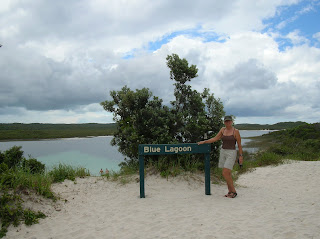

My favorite bird to view has been the Rainbow Lorikeet. (They are known around here as “Lorries,” as per usual with the Australian custom of shortening a word and adding a “y” on the end, for instance “Brisbane” becomes “Brizzy,” pictures become “pickies,” biscuits become “bickies.”) I was lucky enough to see a few Lorries up close and personal at a friend’s feeder. They are beautiful birds, but very noisy. During the day they travel in pairs and are very bossy about their feeding areas. You can hear them all day long, chattering and carrying on up in the trees.
When I was in Noosa a few weeks ago, I was amazed by the large evening feeding groups. They massed in the trees by the river in such huge noisy flocks that you honestly could not hear yourself think. There must have been thousands of them, flying speedily around and chatting in the trees. If they weren’t so beautiful you might despise them! They are also early risers, so don't plan on sleeping in when they are in the neighborhood.
Random ObservationsJen has been kind enough to coach me while I’ve driven her car around the area, giving me some important “coached” practice for when I rent the camper van in New Zealand next month. Driving on the left side of the road is indeed challenging but Jen keeps me on top of the situations. What throws me off the most is that the turn indicator is where the windshield wipers usually are…so I’m constantly turning on the wipers instead of the indicator! This always happens when approaching a 2-lane roundabout. Makes Jen crazy!
What’s also funny is when you’re walking down the street and see someone drive by with a passenger in the front seat, seated on the left hand side where our driver’s seat would be. This person might be staring out the side window, have their hands behind their head, or have their head thrown back in laughter. Your first impression is “Hey, how can you DRIVE with no hands on the wheel? Pay attention!!!” Then you realize that it is a passenger. Oops.
You have to be aware while riding the bike around here, that the rear brake is on your left handlebar, not your right like it is at home. Watch out for those quick stops!
Here’s a good one that my pals in Creative Services will appreciate: You know how when a document you are trying to print is mistakenly set up as an “A4” size and the laser printer refuses to print it, and it spins and spins until someone cancels the job and resizes the sheet to “letter” size? Well, I have the exact opposite problem with the printer here! Most docs are automatically set up as “letter” size, but the paper in the tray is “A4,” so my jobs get rejected unless I change the page set up.
Besides that, the people are nice, the beer is cold and the work I've been doing is rewarding. Just have to watch those windshield wipers!



















